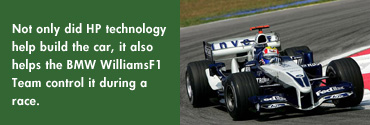
by Brent Gregston
The BMW WilliamsF1 auto-racing team was in a fix. New racing
regulations for 2005 required changes to its cars that could
have reduced nearly 30 percent of the car's total downforce.
That could have meant a difficult racing season for BMW
WilliamsF1, but HP and HP Labs were able to help, providing
cutting-edge utility computing technologies that gave the
team the computing boost it needed to redesign its cars in
time.
Thanks in part to HP, BMW WilliamsF1 was able to perform
the compute-intense computational fluid dynamics prediction
needed to make design changes in time for the European season,
now heading into the challenging Monaco Grand Prix.
"Prediction, using computational fluid dynamics, was
our main tool to assess the implications of the new FIA rules
for the 2005 season, and to consider a wide range of potential
solutions," says Sam Michael, technical director at
WilliamsF1. "Together with our partner HP, we scaled
up our computational resource by a factor of three."
The 2005 BMW WilliamsF1Team car, the FW27, was designed,
and thousands of race simulations conducted, by an HP supercomputer.
The car is competing in 2005 armed with a new chassis and
a new engine.
New regulations for 2005 required BMW WilliamsF1 Team to
raise the front wing by 50 mm, to move the rear wing forward
150 mm and to reduce the diffuser height significantly. In
addition, the floor in front of the rear tire had to be cut
away.
These changes could have slowed the team down, but the
BMW WilliamsF1 Team and HP Labs Bristol – which has conducted
extensive research in utility computing -- rose to the challenge.
Using HP Labs technology and HP utility computing, the WilliamsF1
design team was able to assess twice as many aerodynamic
models in computational fluid dynamics this year than ever
before.
The aerodynamic and structural characteristics of the FW27
were modeled on a powerful HP Linux cluster at WilliamsF1
UK headquarters in Grove. The HP Bristol Labs facility, which
provides enterprise customers with a 'pay-as-you-go' resource,
acted as 'surge capacity' for WilliamsF1, managing peaks
in workload, allowing the team to perform numerous additional
simulations of the FW27 car.
"We augmented our in-house capability with the use
of HP’s Bristol Labs utility computing facility, which
allows us to run computations using external resource at
peak load times, such as during the new car design phase," says
Michaels.
HP technology enabled the team to perform design simulation
of 1.3 terabytes of aerodynamic data (the equivalent of about
69,000 volumes of the Encyclopedia Britannica). The results
of the simulations allowed the team to optimize solutions
for front and rear wings, brake ducts and radiator ducts
without the expense and time of fabrication or wind tunnel
testing.
WilliamsF1 engineers also used the HP Labs utility computing
facility to take structural and crash analysis to a new level
of fidelity by creating sophisticated models of carbon fiber,
which demands a tenfold increase in computer power.
Structural integrity of all Formula One cars is a specific
requirement under the Fédération Internationale
de l'Automobile (FIA) regulations, and therefore plays a
key part in the design of the FW27. Structural integrity
and crash test simulations were carried out in-house at WilliamsF1
UK headquarters in Grove.
Gavin Fisher, chief designer, WilliamsF1 says that "HP's
technology has brought the design team major improvements
year on year and 2005 marks a significant escalation in this
relationship. Access to HP Labs has played a considerable
role in the design and crash testing possibilities for the
new FW27 car."
HP is entering its sixth year as principal sponsor of the
BMW WilliamsF1 Team.
Since 2000, HP has been the technology behind the BMW WilliamsF1
Team, providing a comprehensive range of products, technologies,
solutions and services. These include: Linux-based supercomputing
solutions, wireless local area network (wLAN), mobility computing,
as well as printing and imaging technologies, which support
the team across car design, performance management, manufacturing
and telemetry.
Not only did HP technology help build the car, it also helps
the BMW WilliamsF1 Team control it during a race. Advanced
HP service solutions will provide the BMW WilliamsF1 Team
with 24-hour trackside support at all 19 Grand Prix races
around the globe.
An Open View Storage mirroring system has now replaced the
team's Storage Area Network, allowing for the transfer of
updated information rather than entire files. As a result,
live information is zapped more rapidly and more reliably
to the BMW WilliamsF1 Team from the Grand Prix track, enabling
race changes to be made more quickly.
"HP is committed to further developing the partnership
that started in 2000 with the BMW WilliamsF1 Team," says
Andrew Collis, director, Global Sports Sponsorship, HP.
" It is our aim to provide the team with the breadth and depth of technical
expertise that HP has, making an invaluable contribution to their performance.
|
